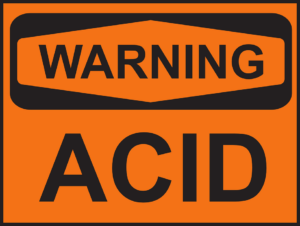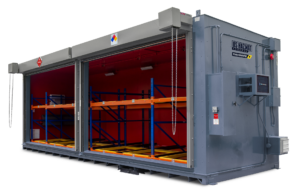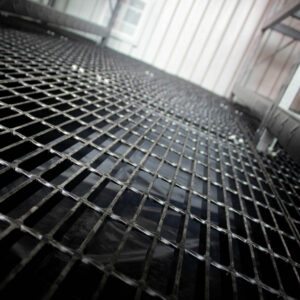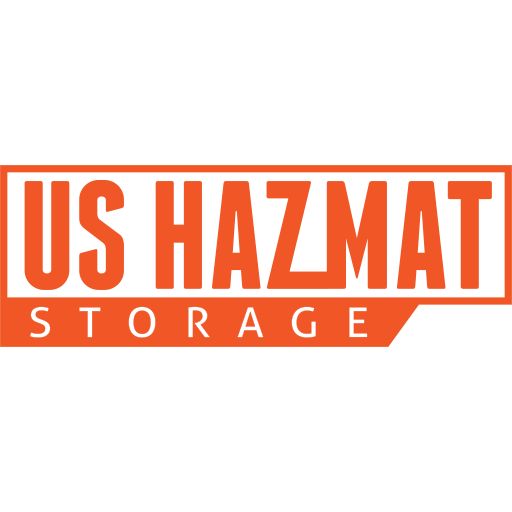Certain chemicals with sinister-sounding names command more attention to detail than benign compounds. Terms such as acid, ethanol, ammonia, formaldehyde and mercury rightfully elicit a hyper-vigilant response from their handlers. While chemical classifications can be misleading and fail to capture the complexity of molecular compounds, the industry’s more dangerous chemicals have reserved a place in national headlines for their propensity for destruction. Even seemingly inert chemical compounds like water can create volatile reactions if mixed with incompatible acids. Unfortunately, synthetic alternatives to toxic but necessary chemicals is limited and derivatives are as equally dangerous. Powerful precursor chemicals, like nitric acid, are commonly used across various industries but come with known risks. We can provide affordable and compliant nitric acid storage, as well as accommodations for all classifications of hazardous materials.
Compliant Nitric Acid Storage Can Prevent a Hazmat Response
Recently, workers an Ogden, N.Y. manufacturer were sent home early. Normally, a shortened workday would be a cause of celebration, but several of the workers are likely trying to calm their nerves after flirting with disaster. While details remain scarce, authorities say a 275-gallon tank of nitric acid spilled in the loading dock area. Fortunately, three workers were able to contain the spill before hazmat crews arrived on the scene. Although plant officials were unable to pinpoint the cause of the spill, authorities are determined to fully vet the factory procedures that led to the breach. While the investigation is in the early stages, authorities said they “discovered something punctured the tank.” Plant managers will likely implement enhanced nitric acid storage protocols to prevent future leaks.
Nitric Acid Health Hazards

Nitric acid is as insidious as it is destructive. Exposure to the dangerous compound can cause irritation to the eyes, skin, and mucus membrane. In extreme cases, exposure could lead to delayed pulmonary edema, pneumonitis, bronchitis, and dental erosion. Moreover, nitric acid is also highly corrosive, as it can residually damage exposed equipment and operating surfaces. While the dangers of noncompliant nitric acid storage are well-documented, annual accidents continue without mitigation. Serious injury from inadvertent nitric acid isn’t infrequent. Decomposition of nitric acid when in contact with oxidizable materials frees additional nitrogen oxides, aggravating the risks of accidental exposure.
Compliant Nitric Acid Storage

Compliant nitric acid storage measures include keeping the container upright and tightly closed in an approved acid storage cabinet. Furthermore, nitric acid should never be stored at or above eye level. Nitric acid storage containers must always be dry as the acid can react with water or steam to produce toxic, flammable, and corrosive vapors. Additionally, avoid nitric acid storage with most metals, including bismuth, manganese, alkali metals, sodium, potassium, and calcium. According to the corresponding safety data sheet, nitric acid is a Category 3 oxidizing liquid. It is also carries a Category 1 corrosive to metal and Category 3 acute inhalation toxicity classification.

U.S. Hazmat Storage can provide fire-rated protection for compliant nitric acid storage. We can ensure two-hour and four-hour fire-rated solutions with solid steel construction and unique spill sump containment capacities. Moreover, our fire-rated storage lockers can accommodate stockpiles of flammable liquids, corrosives, and combustible drum storage protection. For maximum control, we’ve outfitted our chemical warehouses with mechanical ventilation and climate control to ensure accident releases of toxic vapors aren’t allowed to accumulate in lower air densities, reducing the risk of flashovers. Wide-swinging access or roll-up doors allow for the streamlined storage and retrieval of chemical drums and air tanks, enhancing your workflow with centralized capacities. We can also install an eye-rinse station inside the locker for immediate corrective measures in case of accidental contact. Message us today for a free quote and consultation!


